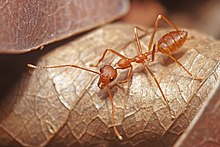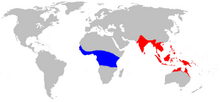Oecophylla smaragdina
| Oecophylla smaragdina | |
|---|---|
 |
|
| Workers | |
 |
|
| Scientific classification | |
| Kingdom: | Animalia |
| Phylum: | Arthropoda |
| Class: | Insecta |
| Order: | Hymenoptera |
| Family: | Formicidae |
| Subfamily: | Formicinae |
| Genus: | Oecophylla |
| Species: | O. smaragdina |
| Binomial name | |
|
Oecophylla smaragdina Fabricius, 1775 |
|
 |
|
| Oecophylla range map. O. longinoda in blue, O. smaragdina in red. | |
Oecophylla smaragdina (common names include weaver ant, green ant, green tree ant, and orange gaster) is a species of arboreal ant found in tropical Asia and Australia. These ants form colonies with multiple nests in trees, each nest being made of leaves stitched together using the silk produced by the ant larvae.
Workers and major workers are mostly coloured orange. Workers are 5–6 millimetres (0.20–0.24 in) long; they look after larvae and farm scale bugs for honeydew. Major workers are 8–10 millimetres (0.3–0.4 in) long, with long strong legs and large mandibles. They forage, assemble and expand the nest. Queens are typically 20–25 millimetres (0.8–1.0 in) long, and normally greenish-brown.
Oecophylla smaragdina has a widespread distribution in tropical Asia and Australia, its range extending from India through Indonesia and the Philippines to Northern Territory and Queensland in Australia. It is an arboreal species, making its nests among the foliage of trees. Nests are constructed during the night, with major workers weaving towards the exterior and minor workers completing the interior structure. The ant colony may have several nests in one tree, or the nests may be spread over several adjacent trees; colonies can reach up to half a million individuals. In one instance, a colony occupied 151 nests distributed among twelve trees. Each colony has a single queen, in one of these nests, and her progeny are carried to other nests of the colony. The average life of a mature colony may be eight years.
Weaver ants of this species are important parts of the ecosystem in tree canopies in humid tropical regions. The nests of this species are constructed by the workers, with leaves being woven together and secured by silk produced by the larvae. First a row of ants line up along the edge of a green leaf and, grasping a nearby leaf, pull the two leaves together, edge to edge. Other workers on the far side of the leaves, each carrying a larva in its mouth, apply the tips of the abdomens of the larvae to each leaf edge in turn. This produces a suture of fine silken threads that secures the leaves together. More leaves are attached in a similar manner to enlarge the nest.
Weaver ants feed on insects and other invertebrates, their prey being mainly beetles, flies and hymenopterans. They do not sting, but have a painful bite into which they can secrete irritant chemicals from their abdomens. In Singapore, colonies are often found in sea hibiscus and great morinda trees which entice the ants with nectar, the trees in return receiving protection from herbivorous insects. In Indonesia, the trees supporting colonies include banana, coconut, oil palm, rubber tree, cacao, teak, jackfruit, mango, Chinese laurel, petai, jengkol, duku, rambutan, jambu air and kedondong.
...
Wikipedia
